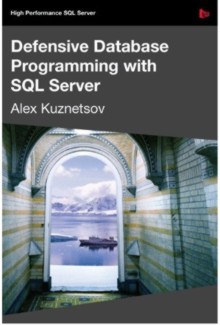| Pick Of The Shelf - SQL Server |
| Written by Kay Ewbank | |||||
| Thursday, 30 August 2018 | |||||
Page 2 of 4
SQL Server for Developers These are the titles aimed squarely at our core audience, the ones written specifically for developers. Murach's SQL Server 2016 for Developers was awarded 5 stars by Ian Stirk, who described it as succeeding effortlessly in its aim of introducing SQL Server to someone new or someone with a basic understanding who wants to learn more. Ian praised its useful screenshots, code samples, and explanations that support the concepts discussed, along with the easy flow between the chapters. In addition to SQL developer concepts, it also introduces some DBA tasks, so acts as a springboard to becoming a SQL Server developer or DBA. Although targeted specifically at SQL Server 2016, much of the book is also applicable to earlier SQL Server editions.
Ian concluded: "The overriding impression I am left with is, everything is explained in a practical, clear and easy manner. This is the book I wish I had when I first started learning SQL Server. If you are new to SQL Server or want to learn more than the basics, this is the book you. Highly recommended."
SQL Server 2017 Developer's Guide is, according to Ian Stirk, who gave the book a rating of 4.2 stars, aimed at SQL Server developers and architects who want to understand the latest features in SQL Server 2016 and 2017. The ideal reader would be an intermediate-level developer with experience of SQL Server 2014, that said, the book does cover some background material from previous versions of SQL Server where appropriate.
Ian found the book generally easy to read, well written, with useful explanations, tips, example code, and diagrams. He says the more you know about SQL Server already, the more useful this book will be, as large subject areas such as database design are omitted since the book focuses on new and enhanced features. One reservation from Ian was that the book is essentially the SQL Server 2016 version of the book, amended to take into account SQL Server 2017, with around 75% of the book relating to SQL Server 2016, and 25% to 2017. That said, if you’re unfamiliar with both SQL Server 2016 and 2017, this book is an excellent starting place, and would merit a rating of 4.8 (out of 5). Overall, Ian says that if you want to know more about the new and enhanced features in SQL Server 2016 and 2017, he can recommend this well-written book. Learning from your mistakes is all very well, but such mistakes can be expensive in time and money. Defensive Database Programming with SQL Server is designed to show you how to avoid pitfalls when developing against SQL Server. While its code examples are in T-SQL the principles explored are more or less universal and apply to all rdbms.
Nikos Vaggalis, who consider this book an indispensable guide was impressed by the way the author shows you how to think proactively and defensively, illustrating the process through numerous hands-on examples. He says that the book is also great for: “related topics such as how to efficiently organize your logic and code by using the numerous facilities this beast of a software, the RDBMS, provides to your own advantage. Like using stored procedures and triggers for both better data integrity and common logic encapsulation while enforcing business rules using constraints or looking at the phenomenon of lost updates.” SQL Server Data Integration Recipes is aimed at developers needing to bring data into SQL Server, and the book gives detailed step by step instructions for taking data to and from a wide variety of data sources, and for how work with the data once you’ve got it into SQL Server. What’s important for developers is that the author shows how to automate this process to save on time and errors, so this isn’t just about how to carry out a task, but how to include it as part of a T-SQL or VB.NET script.
The examples are mainly written in T-SQL, with a smattering of MDX where the author is showing how to handle Analysis Services data. Where he’s writing SSIS scripts he mainly uses VB.NET, though there are a few examples that use C#. The book covers pretty much everything about using SSIS (SQL Server Integration Services), and also covers other aspects of ETL. Kay concludes that most database developers would find some elements of this book useful: You’re unlikely ever to need all of it - if you’re working with DB2 data, the section on working with Access will be wasted, for instance, and in general you’ll probably only use one small part of each chapter - the bit relevant to your particular circumstances. However, the scripts and T-SQL are clearly written and explained, and while you may only use a small percentage of the overall material, that’s down to the multiple options rather than any weakness of the book. <ASIN:1890774960> <ASIN:1788476190> <ASIN:B078WBVRN8> <ASIN:1906434492> <ASIN:1430247916> <ASIN:B00ACC6B8G> |
|||||
| Last Updated ( Tuesday, 09 March 2021 ) |


